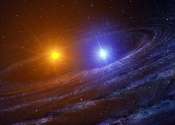New research challenges black holes as dark matter explanation
The gravitational wave detectors LIGO and Virgo have detected a population of massive black holes whose origin is one of the biggest mysteries in modern astronomy. According to one hypothesis, these objects may have formed ...









